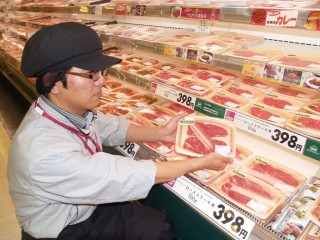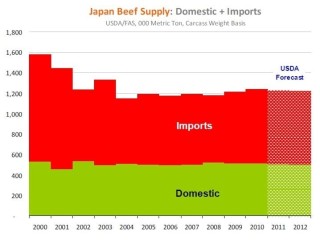 The Japanese Government appears to have confirmed that it is preparing to engage with the US over freer trade access for US beef, currently limited to cattle less than 20 months of age under BSE risk protocols.
The Japanese Government appears to have confirmed that it is preparing to engage with the US over freer trade access for US beef, currently limited to cattle less than 20 months of age under BSE risk protocols.
An agreement by Japan to broaden US supply to include cattle up to 30 months of age would have significant competitive implications for Australian beef exporters.
An original media report quoting unnamed government sources published in the Yomiuri Shimbun newspaper ten days ago (see Beef Central’s earlier item) was followed by reports issued by Reuters and several other agencies yesterday claiming that Japan's Health Ministry had now confirmed it would ask the nation’s Food Safety Commission to review import rules currently imposed on US beef.
Beef import protocols are likely to be one of the key topics for discussion when Japanese prime minister Noda and US president Obama meet for a Japan-US summit scheduled during the APEC gathering in Hawaii on November 10-12.
While the timing remains unclear, trade speculation in Japan yesterday suggested the review is likely to commence in April 2012, the beginning of Japan’s next fiscal year.
A decline in Japanese domestic beef production following April’s tsunami and nuclear contamination event is seen by some US analysts as a partial trigger for the review.
Japan was the biggest international customer for US beef before an outbreak of BSE in the US in 2003, after which the market remained closed until a partial re-opening in July 2006, accessible only by US beef from animals less than 20 months of age, based on concerns that older animals might carry higher BSE risk.
The trade restriction caused about $1 billion in lost US sales a year, according to the National Cattlemen’s Beef Association.
No sudden changes likely
Views out of the US following yesterday’s developments suggest there will be no rapid change in trade access, nor is there likely to be a major overall impact on Australia’s export position.
US Cattle Buyers Weekly publisher Steve Kay says that even if a formal announcement about a review is made this month, it might take a year for the US beef 20-month age limit to be lifted.
“A key factor then will be what Japan accepts as age verification,” Mr Kay told Beef Central.
“Dentition would be the best way to go for the US, but Japan might not agree to this. Depending on what Japan does accept, the number of US cattle eligible for export might still remain restricted,” he said.
 Chicago Mercantile Exchange analyst Len Steiner, commenting in CME’s Daily Livestock Report, said a decision on lifting current age restrictions would have a significant impact on US beef exports to Japan.
Chicago Mercantile Exchange analyst Len Steiner, commenting in CME’s Daily Livestock Report, said a decision on lifting current age restrictions would have a significant impact on US beef exports to Japan.
US beef shipments had increased steadily in recent years but remained only a portion of what they were prior to the BSE-related ban, he said.
In 2010, US beef exports to Japan were estimated at 160,000t (carcase weight equivalent), compared to 417,000t in 2003. At that time, the US and Australia typically shared about 48pc each of Japan’s total imported beef volumes.
According to the latest calculations from the US Foreign Trade Service, quoted by Mr Steiner, the total beef supply (domestic and imported) in Japan in 2010 was estimated at 1.355 million tonnes. Imported beef accounted for 53.2pc of the overall Japanese beef supply in 2010, with much of this coming from Australia, a little from New Zealand, and a small but growing share from the US.
“Beef trade patterns in 2011 have shifted considerably, largely due to the exchange rate effects which have made US beef more competitive, but also due to the disruptions brought about by the tsunami and nuclear accident,” Mr Steiner said.
“Our current working estimate is that US beef exports to Japan in 2011 could be around 215,000t (CWE), accounting for 15.9pc of the overall beef supply in the country.”
“Should Japanese officials lift restrictions on US beef in 2012, we could see US beef shipments rise steadily for the next two to three years and eventually approach the levels we saw back in 2003,” Mr Steiner said.
“It is conceivable that the decision could add another 54,000t to US beef trade with Japan in 2012 and probably another 70,000-90,000t in 2013.”
Mr Steiner’s comment here is obviously predicated on a rapid Japanese review process being implemented and finalised, which does not align with broader thinking on how the process will unfold from here.
Growing the beef pie in Japan
He said while the US could displace some Australian beef in the Japanese market, he thought the entry of larger quantities of grainfed US beef would largely increase the overall beef supply in Japan.
“Keep in mind that Japanese beef consumption in 2011 is estimated to still be about 10pc lower than it was in 2003, in large part due to the absence of US beef. In other words, the lifting of restrictions will tend to make the size of the market larger, rather than ‘taking’ volume away from current suppliers such as Australia.”
Higher seafood prices, a staple in the Japanese diet, would further support higher consumption and thus larger US beef exports and he suggested that CME's estimates should be seen as ‘very conservative.’



HAVE YOUR SAY